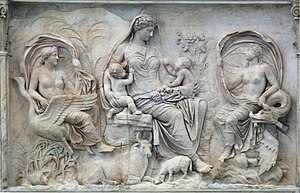The study of ancient Roman sculpture is complicated by its relation to Greek sculpture.
Many examples of even the most famous Greek sculptures, such as the Apollo del Belvedere and the Barberini Faun, are known only from Roman Imperial or Hellenistic "copies."
At one time, this imitation was taken by art historians as indicating a narrowness of the Roman artistic imagination, but in the late 20th-century, Roman art began to be reevaluated on its own terms.
Some impressions of the nature of Greek sculpture may in fact be based on Roman artistry.
Examples of Roman sculpture are abundantly preserved.
Latin and some Greek authors, particularly Pliny the Elder in Book 34 of his Natural History, describe statues, and a few of these descriptions match extant works.
While a great deal of Roman sculpture survives more or less intact, it is often damaged or fragmentary.
Main article: Roman portraiture
Portraiture is a dominant genre of Roman sculpture, growing perhaps from the traditional Roman emphasis on family and ancestors.
During the Roman Republic, it was considered a sign of character not to gloss over physical imperfections, and to depict men in particular as rugged and unconcerned with vanity.
The portrait was a map of experience.
During the Imperial era, more idealized statues of Roman emperors became ubiquitous, particularly in connection with the state religion of Rome.
Tombstones of even the modestly rich middle class sometimes exhibit portraits of the otherwise unknown deceased carved in relief.
Among the many museums with examples of Roman portrait sculpture, the collections of the Metropolitan Museum of Art in New York and the British Museum in London are especially noteworthy.
Religious art was also a major form of Roman sculpture.
A central feature of a Roman temple was the cult statue of the deity, who was regarded as "housed" there (see aedes).
Although images of deities were also displayed in private gardens and parks, the most magnificent of the surviving statues appear to have been cult images.
Roman altars were usually rather modest and plain, but some Imperial examples are modeled after Greek practice with elaborate reliefs, most famously the Ara Pacis, which has been called "the most representative work of Augustan art."
Small statuettes, executed with varying degrees of artistic competence, are plentiful in the archaeological record, particularly in the provinces, and indicate that these art objects were a continual presence in the lives of Romans, whether for dedicating at a temple or for private devotional display at home or in neighborhood shrines.
Roman sarcophagi, mainly dating from the 1st to the 4th centuries CE, offer examples of intricate reliefs that depict scenes often based on Greek and Roman mythology or mystery religions that offered personal salvation, and allegorical representations.
Roman funerary art also offers a variety of scenes from everyday life, such as game-playing, hunting, and military endeavors.
Scenes from Roman sarcophagi
- Scenes of Orphic religion (2nd century)
Scenes shown on reliefs such as that of Trajan's column and those shown on sarcophogi reveal images of Roman technology now long lost, such as ballistae and the use of waterwheel-driven saws for cutting stone.
The latter was only recently discovered at Hieropolis and commemorates the miller who used the machine.
Other reliefs show harvesting machines, much as they were described by Pliny the Elder in his Naturalis Historia.
The architectural writer Vitruvius is oddly reticent on the architectural use of sculpture, mentioning only a few examples, though he says that an architect should be able to explain the meaning of architectural ornament and gives as an example the use of caryatids.[2]
| Ancient art history series |
|---|
| Middle East |
| Asia |
| European prehistory |
| Classical art |
[edit]
See also
- Roman art
- Roman engineering
- Roman technology
- Classical sculpture
- History of sculpture
- Ancient Roman pottery
- Gallo-Roman art
[edit] References
Further reading
Conlin, Diana Attnally, The Artists of the Ara Pacis, University of North Carolina Press, 1997.Hallett, Christopher H., The Roman Nude: Heroic Portrait Statuary 200 BC - AD 300, Oxford University Press, 2005.
Kleiner, Diana E.E., Roman Sculpture, Yale University Press, 1992.
Gerhard Koeppel, "Official State Reliefs of the City of Rome in the Imperial Age: A Bibliography." ANRW II.12.1, 477-506.
Koortbojian, Michael, Myth, Meaning, and Memory on Roman Sarcophagi, University of California Press, 1995.
Mattusch, Carol A., The Villa dei Papiri at Herculaneum: Life and Afterlife of a Sculptural Collection, J. Paul Getty Museum, 2005.
Ryberg, Inez Scott, Rites of the State Religion in Roman Art, American Academy in Rome, 1955.
Varner, Eric R., Mutilation and Transformation: Damnatio Memoriae and Roman Imperial Portraiture, Brill, 2004.
[edit] External links
- "Roman art: Sculpture". The Columbia Electronic Encyclopedia, 6th edition. © 2006. Columbia University Press / Infoplease. Visited May 28, 2006.
- Ancient Roman sculpture
- Comprehensive visual documentation of Ara Pacis Sculpture".












No comments:
Post a Comment